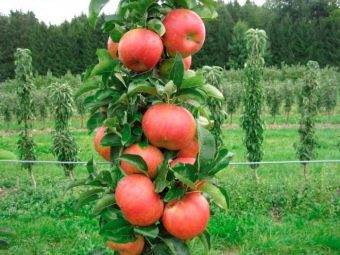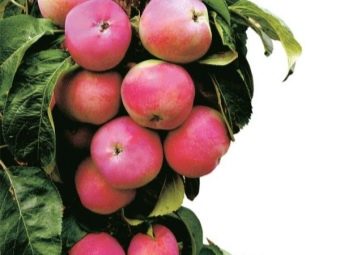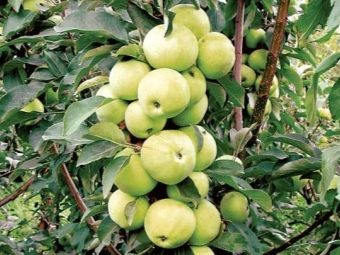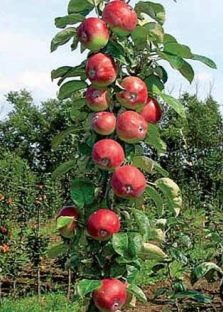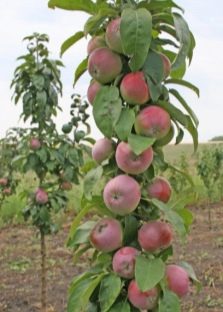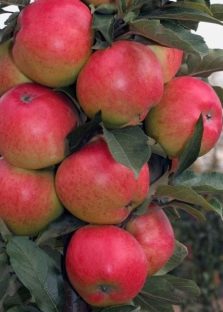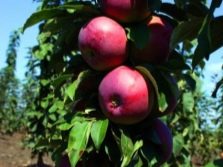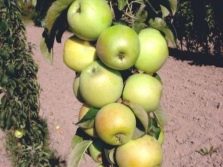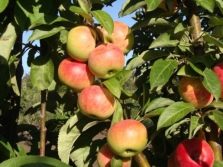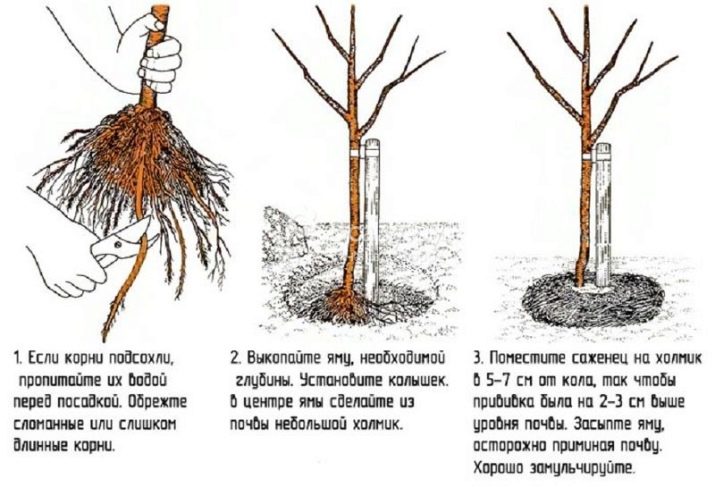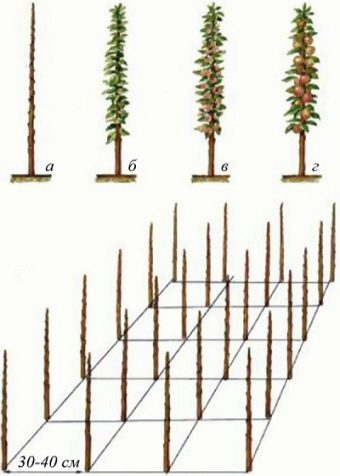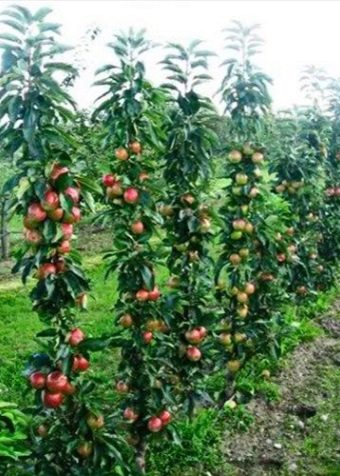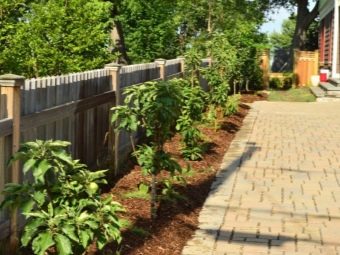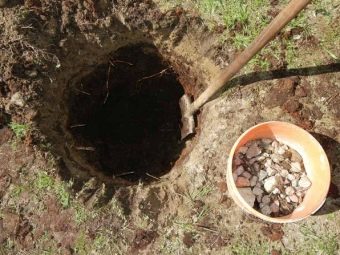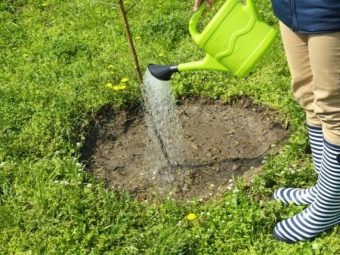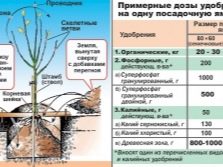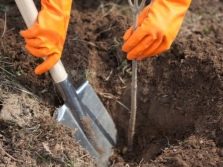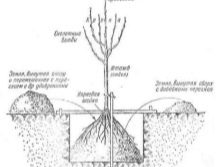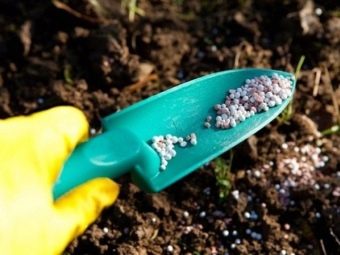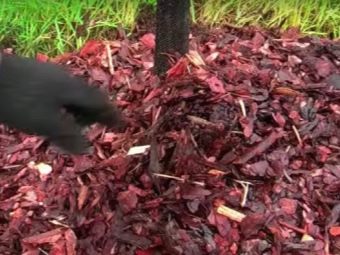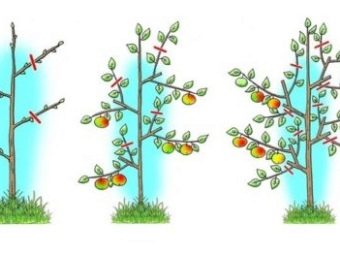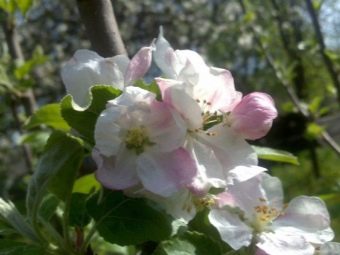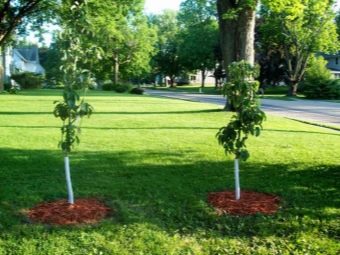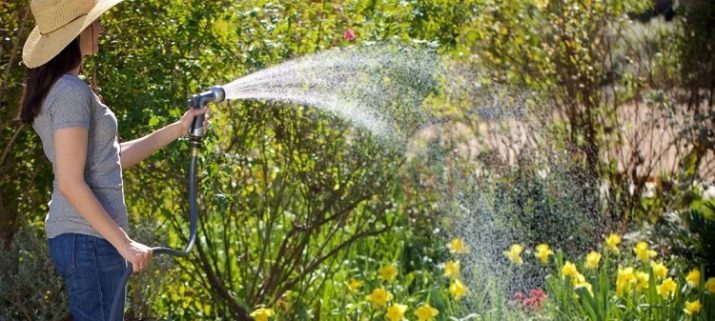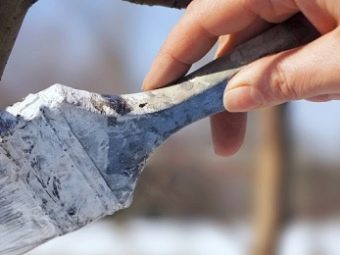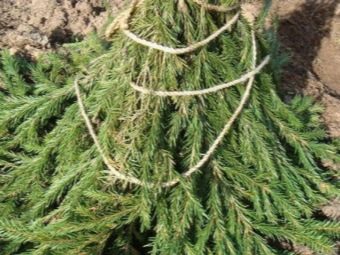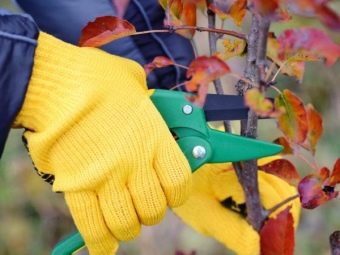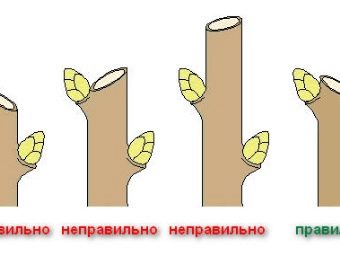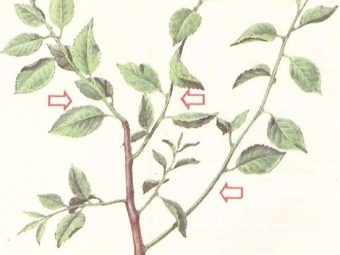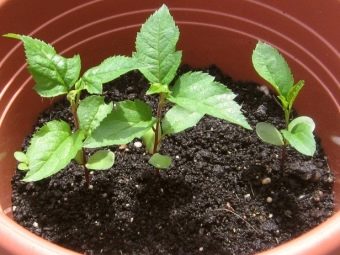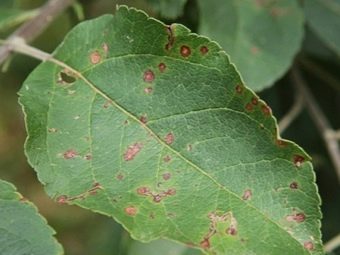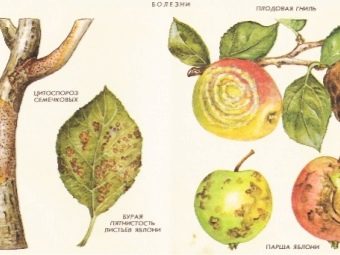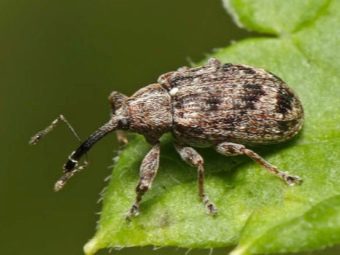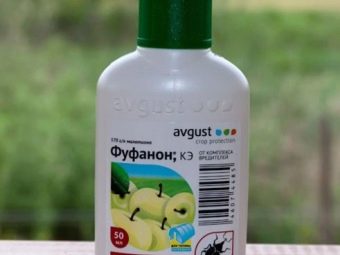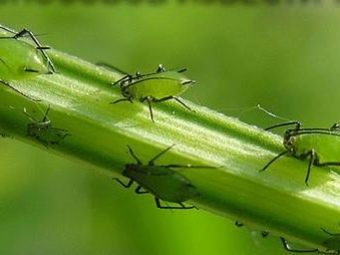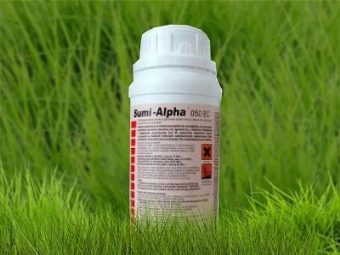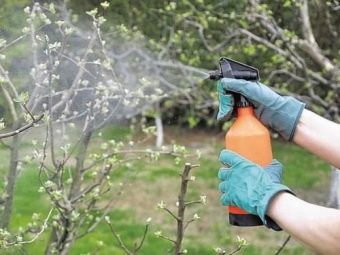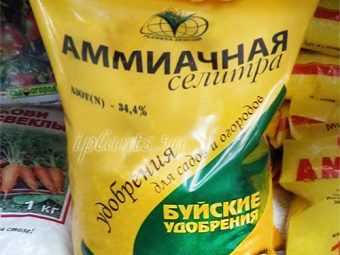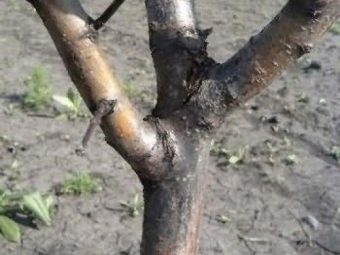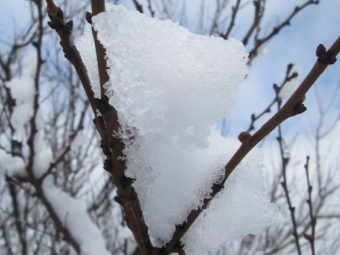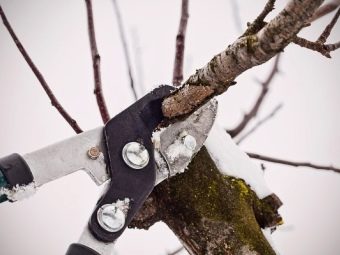Celled Apple Trees: Cultivation Subtleties and Disease Control
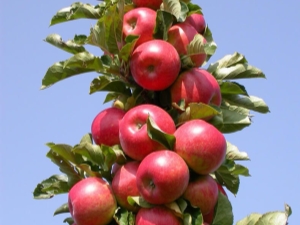
It would seem, what else breeders can surprise with the existing variety of apples. There are two or three trees in each garden area, and we are used to the traditional look of their spreading crowns. In the summer heat, they give such a necessary coolness in the shade. However, for those who have a very small garden, the columnar apple, which does not have a crown in our classical sense, will be an ideal choice. It takes up very little space, and these plants can be planted in the country or garden a dozen.
Features and varieties
An unusual view was derived by chance. This event happened in South America. In the sixties of the twentieth century, a careful scientist accidentally saw a non-standard branch on an ancient half-century apple tree. It was without lateral processes, densely covered with foliage and large apples. Such a bizarre game of nature was the impetus for creating a new variety. Ten years later, breeders from England managed to create a fundamentally new look with the required characteristics.
Later it became known that the trees have such an unusual pillar-like shape due to the presence of their particular gene. These apple trees have a thicker than the classical species, trunk. In fact, there are side branches on it, only they are very small and grow very close to the trunk at an acute angle. Lives such a beauty from fifteen to twenty years.
The relatively short lifetime of the plant is compensated by the rapid entry into the phase of fruiting. Crop begin to collect in the second year. At the same time, by the age of five it becomes good and stable, and in the next two years it only increases.
In connection with this feature, two types of apple trees should be distinguished. The first has a mutational gene Co in its pure form. These varieties and protect especially from the influence of negative impacts on the top of the trunk. Others are descendants of common varieties that have been planted on super-dwarf plants. They need pruning and shaping. Winter frost is not so bad for an apple tree even in the first years of life.
Today there are more than a hundred varieties intended for cultivation in different regions. They differ in taste, maturation (late, early and medium), the height of the plant. Initially, columnar plants came from the south, and new varieties were bred for warm conditions. But now there is an opportunity to grow an interesting exotic variety in summer houses of the middle lane. It goes without saying that it is necessary to choose frost-resistant apple trees.
It will feel good in the climatic conditions of the central region "Amber Necklace". On the medium-high tree grows small-sized fruits of golden hue. This late ripening type is not afraid of winter frosts and has a very high yield. The taste of juicy apples is sweet and sour, pleasant, with a granular structure of the flesh.
For the earliest ripening of large greenish apples of the variety "Cheburashka" require a good illumination of the plant by the sun. The plant is cold resistant and has a high yield. By the fifth year of growth, the trunk is simply covered with apples with a pleasant sour taste. Cheburashka is also appreciated for its high resistance to many diseases of fruit trees. The fruits are good for all kinds of conservation.
Universal late ripening variety "Chervonets" suitable for growing in most regions of Russia. Compact size allows you to grow a lot of trees in the garden and get a big harvest in the third year from the moment of planting. Apples are very beautiful, large size, burgundy color. This species is distinguished by excellent tolerability of cold weather and strong immunity to garden insects and tree diseases. The peculiarity of sweet fruits is that they should be removed from the tree in time, avoiding over-ripening and, especially, dropping of apples.
Medoc best suited for suburban cottages. Large, very sweet apples with characteristic notes of honey aroma ripen at medium height. The tree withstands frosts below thirty degrees, but needs timely spring treatment from pests. With good care from one plant you can collect about eleven kilograms of apples.
Bred recently by domestic breeders "The president" very compact and at the same time harvested. Sour apples ripen at the end of the summer and may last until the New Year holidays. The variety can be grown even in Siberia and the Urals due to its ability to withstand forty-degree frosts. About nine kilograms of yellow apples are harvested from the plant.
Late maturity "Vasyugan" It can also be cultivated in areas with harsh natural conditions. Tall apple trees will survive the Siberian frosts. On the tree grow cone-shaped, covered with yellow stripes scarlet apples, sweet, with a slightly noticeable sourness.
Large fruits ripen to the beginning of autumn, but can not withstand long storage. Use them better fresh from the branch.
Semi-dwarf leaf-forming apple tree Ostankino can give odds to his tall congeners. With a good summer, harvesting from one tree can be up to fifteen kilograms. The variety does not require much time for care, as it has a high resistance to all sorts of pests and is almost not susceptible to diseases. Fruits grow large, light green with a scarlet side, which (with enough light) can stain the entire skin. Sweet apples ripen completely in September and can be stored for several months.
Very sweet red variety apples "Triumph" collected by October. Trees will delight not only the dessert qualities of the crop, but also their decorative fancy look. Despite the small size of apple trees, they bring a stable good harvest.
"Arbat" most suitable for planting in the middle lane due to its cold-resistant qualities. Bright cherry color sweet fruits ripen late, their main harvest falls at the end of September and even October. Medium-sized fruits have good lezhkost. They are also suitable for processing into jam, jam, compotes, marshmallow.
Kolonovidnaya "Currency" is a winter variety. Harvest can be very late in late October. He will lie through the winter until the spring. The grade is appreciated for resistance to diseases and flavoring properties of fruits. Apples are yellow, weighing up to two hundred grams, with a sweet taste and a very pleasant aroma.
"Moscow Necklace", contrary to its name, suitable even for cultivation in areas with difficult climatic conditions. Plants of this species are very winter-hardy and delight in strong immunity to diseases of various kinds. The peculiarity of the tall trees of the Moscow Necklace is that in order to successfully pollinate them, other varieties will have to be planted on the plot. Late-ripened red-skinned apples have a good sweet taste with a little acid.
Apple tree "Maluha" Named for its super compact size. Fruits on it at the same time ripen rather large with an average weight of 150 grams, slightly elongated, with skin of green-yellow color. High yield varieties complemented by precocity. Knowledgeable gardeners love him for the excellent taste characteristics of apples and their delicate aroma.
Sort "Gin" will delight lovers of great harvests. It is quite suitable for landing in the middle lane due to its high frost-resistant qualities. Bright red apples can be stored all winter. Their size can vary with weight from 90 to 180 grams. Taste is usual, sweet-sour, with juicy crunchy flesh when biting. Good "Jin" and its universal use in cooking.
"Yesenia" popular because of its resistance to extreme cold and fruit tree diseases (especially scab).Apples grow large in size, with raspberry-scarlet, wax-coated skin.
Landing
For excellent harvest on unusual ornamental plants, pleasing the eye, you should choose the right sapling. This is one of the keys to success in the cultivation of columnar varieties. Gardeners choose this breeding method as the easiest. Plants can be propagated by seed or graft. But the first method is very time consuming and effortless. And the second is suitable for professionals, as it requires a lot of special knowledge.
Therefore, the most optimal for most gardeners is the method of breeding seedlings, which should be bought in the nursery. The specialists will be able to clarify some subtleties in the agrotechnology of each individual variety.
The best choice would be a one-year sapling. He has a greater survival rate and adaptability. Do not forget about climatic zoning when buying a new apple variety. Well, if the root system is closed in a pot or at least a package.
Before purchasing a tree, you need to examine the root system for damage and disease. Do not take a plant with too dry roots. His chances of survival when landing will be very small.
It is preferable to choose a well-illuminated area for the future apple orchard. However, it should be sufficiently sheltered from the winds. This is important because of the specificity of the variety with a compact root system and the absence of a crown. With a strong wind, such a tree with a height of 2-3 meters without strongly pronounced lateral branches can simply fall.
Prefers culture light, fairly fertile, neutral in chemical composition of the soil. It is important to ensure good drainage at the landing site. If groundwater is sufficiently close to the ground, then such a site is not suitable for columnar apple trees. Their root system with a long main root and a very small lobe of the lateral roots can blur, and the tree will inevitably die. It is necessary that before the course of groundwater was not less than 2-2.5 meters.
Summer
Planting of columnar apple can be in the summer. To get a good harvest the next year will need to show a little more care for the tree. It is better to choose a grade in the checked gardening facilities. There you can get a plant that is dug right in your presence. Plant an apple tree in a prepared pit, as in the spring and autumn planting.
First you will need to prepare the sapling itself: the day before this, the roots should be well moistened or lowered into warm water for several hours before planting. Some in the pursuit of the harvest are trying to make an apple tree in the first year. This is wrong, as the plant spends strength on fruiting, instead of taking root well and preparing for winter. If you decide to plant a plant in the summer, you should cut off all the emerging flower buds. The tree will thank the harvest for the next season.
In addition, you need to properly plant, you must comply with the watering mode. Culture is rather moisture-loving, in the first three years special attention should be paid to this. The soil will have to be watered at least twice a week, depending on weather conditions.
For one sapling up to two years old when watering you will need one or two buckets of water. Periodically in the first summer of planting it will be necessary to loosen and mulch the soil every two weeks.
In the spring
When planting in the spring, a pit for a seedling is prepared from autumn in the manner described above. During the winter period, the soil will get better, and mineral fertilizers will dissolve in the soil to the necessary concentration, which the spring seedling can easily absorb. Planted in such a way young trees take root better and bloom in the first spring.
To keep the apple tree stronger, the first fruits are plucked, leaving only a few pieces. Thus, the columnar variety will be able to retain its strength for good rooting and fight against spring temperature changes.
An important condition for the cultivation of plants: planting is done before the opening of the first buds. It is good to spray the tree with a solution of frost, as well as a fungicide. If the winter was of little snow, and there was little rain in the spring, the apple tree would need timely watering up to two times a week.
In the autumn
At least two weeks before landing, you should prepare a future seat. In the pit under the seedling all fertilizers should be well dissolved, and the adjacent soil should be compacted. If this is not done, then after planting the basal lobe can drown under a layer of soil, which is very harmful for the young tree.
When planting a large number of apple trees, the space is organized in rows, the gap between which must be at least one meter. The distance between the trees in a row can withstand about fifty centimeters. Next, dig holes for plants that are prepared in a special way.
The size of the pit should be not less than 0.8 by 0.8 meters and about one meter in depth. When digging, the upper fertile layer of soil is separated to the side without mixing it with deeper sandy and loamy layers.
If the soil is acidified, 100-150 grams of lime or chalk are added to the site. In case of heavy, poorly drained soils, a large amount of expanded clay is poured into the bottom of the groove. It can be replaced with a mixture of medium-sized stones (about 2-3 centimeters) with sand in a one-to-one ratio.
After preparing a nutritional mixture of three buckets of compost or humus, one hundred grams of superphosphate and one hundred grams of potash fertilizers. All pour into the ditch, mixing well. If necessary, in the absence of precipitation, water is poured over the soil. For 10-14 days the soil should settle down properly.
With the direct landing in a hole, the top layer of soil, which was thrown away during digging, was poured aside. An apple tree is installed on such a hill so that the border of the trunk and roots is above ground level. The root system is poured on top of the remaining soil and carefully ram. Need to pour a fresh landing; This will require up to two buckets of warm water. Often, a support for further garters is installed next to the seedling. After the soil dries, the trunk circle is mulched. For this purpose, suitable branches, grass, peat, sawdust.
Care
Proper care in the springtime is pruning, processing from pests, nitrogen fertilizing and removing excess ovaries. Prior to budding, trees are necessarily formed. Spray branches with buds common universal fungicides. Instructions for their use are usually on the package. For one tablet or ten-gram bag with the active substance take 10-12 liters of water. First, dilute the chemical in a liter of warm water, stirring thoroughly. Then bring the solution by adding pure water to the desired concentration. Spray the plant with a protective mask and gloves away from children and animals.
It is important to feed the sapling with nitrogen fertilizers for better growth of the tree and the formation of foliage. Celled apple trees give a lot of fruit, so they take a lot of nutrients from the soil. They need replenishment. For this, urea can be used, swollen, bovine or horse manure diluted in a ratio of one to ten. Feeding is carried out no more than twice in the spring, usually in April and in May. Fill the lack of nitrogen in the soil and fermented bird droppings. Also recommend spraying the branches at the stage of formation of the kidneys with a seven percent solution of urea. It will serve not only as fertilizer, but also as a plant protection from diseases.
It is also advised to make an available substitute for organic fertilizer from food waste or first grass.For such a fertilizer, you need a barrel or a bucket, which is half filled with waste or compost - maybe two-thirds - of the volume, the rest is filled with water and infused for one week. When the characteristic odor of fermentation appears, the infusion can be used for top dressing by diluting with warm water at a temperature not lower than 20 degrees in proportion to one part of the fertilizer per ten liters of water.
For the proper formation and development of the apple you need to properly cut off the growing flower buds. In the first year of life, it is desirable to remove them all. You can leave 2-3 flowers to see which fruits will grow. For the next season, about a dozen peduncles are left on the tree. Gradually, starting from the third year, they increase the number of fruits, as the plant becomes stronger and can already withstand a sufficient load on the trunk. Thus, a three-year-old plant initially leaves twice as many ovaries in the spring as it will be harvested. In the summer, when the size of each fruit will be approximately from ripe cherries, on each double inflorescence one of two apples is plucked.
Depending on the amount of precipitation in spring, the apple tree must be watered at least once a week. The earth in the circle wheel is loosened for better access of oxygen to the roots after each soil moistening.
So that the ground at the apple does not overgrow with weeds, the ground is mulched. Sometimes this is not possible if there is a young graft on an apple tree with a weak root system. Then, in order to avoid injuring the plants, siderats are planted around the rootstock of the stock, which are periodically cut with scissors or mowed, laid side by side.
In the summer, with active fruiting, trees need watering and weeding, if the stalk area has not been mulched. In the first half of June, columnar apple trees are fertilized with high phosphorus and potassium mineral complexes for better fruiting. This can be done by pouring a solution from a watering can for faster penetration into the soil. If the summer is rainy, for a more lasting effect, you can apply dry fertilizer, digging the soil ten centimeters. To do this, you will need about a glass of granulated fertilizer to process one to two square meters in the near-stem circle of a three-year-old seedling.
Compliance with the irrigation conditions will provide the young tree with a good survival rate and rooting, and the grown up tree will have strong immunity and an excellent harvest. In the case of apple-shaped apple trees, the roots are quite compact in the upper soil layer, so in hot weather you need to water them every other day. In a normal, not dry summer season, the land is irrigated twice a week. In one of them, the soil is necessarily well soaked abundantly. In mid-summer, watering is reduced by a third. And to harvest it stops altogether for about two weeks.
An effective and convenient way for the cultivation of such plants will be automatic drip irrigation. At the same time, once a month, the apple tree should be watered well in the usual way, wetting the ground around the barrel radius to the depth of the spade bayonet. Experienced gardeners recommend twice a month after sunset to irrigate the plants' crowns themselves with a hose with a small spray nozzle or a conventional chemical sprayer with clean water.
In June, you need to periodically inspect the apple for the appearance of various pests. When they are detected, the tree is urgently sprayed. At the same time they use both folk remedies in the form of a solution of soap and wood ash, as well as publicly available store fungicides. Two to three weeks before the intended harvest, the chemical treatment is stopped.
At the beginning of summer, the formation of the required number of fruits on the sapling, which was started in spring, also continues. From several ovaries in one bunch only one fruit should remain. In late summer, fertilizers under the apple tree cease to apply.For good growth of new shoots, you can use a small amount of potash fertilizers, and nitrogen remain until the new spring. The preparation of the columnar apple for wintering begins. To this end, four sheets are cut off at the very top so that it does not freeze.
It is necessary to take care of the plant after the end of the season. To grow a healthy tree will help proper pre-winter preparation. In the autumn, after harvesting, digging in the ground is done with complex fertilizer. The bottom of the barrel whitewash whitewash, lime or a special solution. The soil, bark and the plant itself are treated for fungal diseases and insect pests. The shtambs of the youngest trees are covered with fir branches for the winter. Instead, you can take well dried wood chips. You should not use for this purpose grass or straw, as it attracts hungry rodents. When the snow has settled well, the base of the tree is well covered with snow so that the hillock does not freeze, and the bottom of the trunk is protected from animals.
Gardeners often wonder about the need to trim the branches of a tree. It should be remembered that a true columnar variety with a mutated gene does not need crown formation. If a dwarf variety grows in the dacha, then you should know some rules for pruning such a fruit tree.
Forming is performed in the spring, in the autumn it is extremely undesirable to do this. They do pruning after the leaves fall in the summer or before the buds open. At the same time, the law of direct proportionality is valid: the more part of the shoot is plucked, the stronger it will grow. On plants of different ages, branches are formed differently.
In any case, the main rule is: you can not trim the main trunk. Otherwise, the apple tree will cease to grow and will begin to give side shoots, having turned from the columnar form to the usual dwarf variety. In the first year of growing on the site, the side processes are cut so that they have two fruit buds. For the next and third year of life, the plants form new buds, leaving short branches with two or three fruit ovaries after last year’s cutting. Unwanted branches without inflorescences are removed, while they are still young and did not have time to stiffen, so the tree survives better.
Carry out on the columnar apple and sanitary pruning, removing the diseased, affected and old processes. After three years of active fruiting, the stiffened branches are pruned, since they will no longer give them the next season. Such old fruit links that have ceased to function are removed to the very base.
In the event that the apical point of growth did not withstand the winter or died for other reasons, it should be pruned, leaving only one pair of fruit buds. Of them must grow two shoots. The following year, only one of them is left to grow, which is more located vertically (stretches in height, but not in breadth).
Growing the columnar type as a whole requires special labor time only in the first three critical years, the most important for the life and development of the plant. Reproduction of such apple trees requires more serious efforts. Traditional grafting on a suitable stock can be difficult for gardeners without the right experience. In this case, the breeders advise not to plant the plant, but to use the method of aerial propagation of plants.
For this, in early spring, choose an available in height not stiffened branch with a thickness of no more than a finger. At its base, the bark is trimmed with a ring. It should not be too narrow, about four millimeters thick. On the day of the incision is wrapped in cotton wool or a soft cloth dipped in a solution of the pig. After such a compress, the plastic bag with wet peat, which is wrapped around the cut, is replaced with a black color. It will periodically need to be moisturized. The package must be well protected from ingestion of oxygen.Roots should appear at the site of the spring cut in about September. This branch is cut from the tree and planted independently in the ground.
Diseases and their treatment
In general, the modern work of breeders allows gardeners to care little about the treatment of diseases of columnar apple trees. They have sufficiently strong immunity to various fungi and are little affected by insects. But it also happens that a young apple tree does not bloom, does not bear fruit in the third year, and dries even with excellent care. The reason for this may be a tree infection. If it is detected at an early date, you need to quickly take steps to eliminate the disease and save the plant. The best way to do this, of course, will be spring prevention by spraying the apple from pests.
Diseases of ordinary fruit are also characteristic of columnar trees. This may be proliferation, fruit rot, mosaic varieties, common cancer, scab and rust. This plant has one advantage over conventional branched trees: it is easier to process. This can be done with an ordinary small sprayer with a vessel on its back or even manually with a paint brush.
Apple moth is one of the most common pests and the eternal headache of many gardeners. Its larvae winter in cocoons in the ground, and in the spring turn into butterflies and lay new offspring in flowers, on leaves and ovaries of a tree. The larvae invade future fruits and eat them from the inside. Thus, crop losses sometimes amount to up to fifty percent of the total.
For the prevention of the reproduction of the pinwort, all fallen apples should be immediately collected and used or thrown into the compost pile. In the fall, the earth is carefully digged and removed organic residues. Within a week after the beginning of flowering, trees are treated with Mitak, Intavir, Biorin or Zeta. The consumption of the working substance is specified in the instructions for use. Usually it is one packet of substance (ampoule, powder or tablet) for 10-12 liters of water. Such processing is desirable to hold two more times with a multiplicity of two to three weeks. Stop it about a month before picking apples.
Apple blossom tree is dangerous because it wakes up very early and its appearance is difficult to notice. He survives the winter under the bark, the foliage and other invisible shelters. In the spring he gives the larvae, which are also introduced under the bark, into the branches and the very cores of the flower buds. If time does not notice the pest, then you can lose the entire crop. Traces of its vital activity are distinguished by brown buds covered with mucus. They often begin to fall massively.
The spraying of kidney swelling with a solution of the drug "Fufanon" helps to cope with the color beetle. The following processing during the opening of flower buds is carried out with Intacid-M solution. At the very beginning of spring, when the average daily temperature does not exceed 12 degrees, you can simply shake off the bugs from the branches. During this period, they are still little active and did not have time to acquire offspring.
Apple tree honey (in the people "leafblock") is a very small bug with transparent wings, well disguised. But it is easier to notice his larvae, these are orange or yellow thick worms. They hibernate in the egg, preferring a place under the bark or at the base of the kidney. When blooming leaves, the larvae begin to activate and eat the plant, sucking out all the juice. The tree begins to slow down growth, can stop flowering. Individual affected parts simply dry and die.
A good effect against insect give folk remedies. For early spraying, it is good to use a solution of tobacco or wood ash with the addition of soap for better deposition of the solution on the branches. For ten liters of water for the preparation of funds take up to half a kilo of ash and two tablespoons of soap (you can use liquid toilet).If the damage to the plant was not detected at an early stage, it is advisable to use chemical preparations, such as Fas or SumiAf.
Aphid on the apple tree brings significant damage to the plant. She likes to spend the winter under the bark of the apple tree, and her larvae usually eat up the youngest and tender shoots on the tops. For this reason, aphids are difficult to detect. It is also hidden on the back side of the sheet, highlighting its adhesive substance on the surface. As a result, the leaves curl, shoots become crooked, the plant loses its strength and becomes ill.
Ants often become the carriers of aphids, so the root cause should be dealt with in order to be most effective. Ant killing preparations are sold freely in stores and are highly effective. Enough, as a rule, one treatment. For the destruction of aphids, there are proven simple means, such as a solution of ash, tobacco dust, or an infusion of onion peel. In case of mass distribution of a pest, it is worth using IntaVir.
Scab is a fungal disease. Its appearance is especially favored by overgrown abandoned areas in gardens, combined with high humidity lasting more than a week. To date, scientists have created gene-resistant apple species that are resistant to the disease. Spends winter scab in autumn leaves and other rotting plant debris. In spring, when the rains begin, the spores of this fungus swell and enter the breeding phase. On the foliage and fruits appear shaggy gray-green spots. Affected crops slow down their growth, and the quality of their fruiting decreases.
For the destruction of malicious scab use a blue solution of Bordeaux mixture (five percent). After three weeks, the procedure is usually repeated. You can also use the drug “Skor” for spraying. To prevent the disease from spreading through the garden, the soil should be well cleaned of organic residues in the fall and shed with ammonium nitrate solution, using 600 grams per bucket of water. The soil should be watered evenly around the circle of a circle within a radius of about one meter.
If the apple tree suddenly began to dry, then the cause is most likely a disease, popularly called flaxet. This fungal disease appears on branches and bark, forming dark spots with a purple tinge that grow in breadth and depth. Gradually, the surface of the bark cracks and becomes covered as if ashy ash. Affected fruits rot, become covered with raw ulcers and wrinkle.
Such a disease usually affects the old plants, which are already more than fifteen years old. But you can carry out prevention on young apple trees. To do this, you need time to cut off the old dried three-year branches, collect fallen fruits and destroy the affected. If there were traces of the fungus on the branches, then the affected areas are cleaned with a sharp, fire-treated or alcohol, knife, grabbing at least 0.5 cm of a healthy tree in depth. The sections are then washed with a 5% solution of copper sulphate.
For better healing, large areas are smeared with garden pitch for trees.
What to do if the apple tree is frozen?
In areas with a harsh climate, you should choose seedlings, zoned for a specific area. They must withstand temperatures not lower than thirty degrees in order to avoid freezing of the top of the growing part. Although initially a columnar apple tree was selected as a southern species, in recent decades, varieties have been created that successfully grow even in Siberia. For optimal wintering, at least four sheets are removed at the top of the trunk in the fall.
If the apple tree is still frozen, then you should not despair. This does not mean the death of the tree, it just may begin to grow more actively from the bottom in breadth. To avoid this, you have to start forming the plant. To do this, the frozen tip is cut to the first two viable buds. Over time, they will grow to 10-15-centimeter shoots.The following year, one of the branches is removed, leaving the most straight, stretching up. At the same time, it is desirable to remove an extra shoot before it hardens - this is how a tree will more easily transfer stress.
The correct pruning process plays an important role in the further growth of the apple tree. The cut should not be at a too sharp angle and spread. For a perfect surface it is better to use a knife. The hem after circumcision should not be too short for the kidneys to grow well. The cut itself is conducted in the direction from the base of the branch to its top. It should be free of bark injuries and a burr on a woody middle. Cut off the frozen branch, retreating about two fingers in height from the kidney.
Gardeners reviews
According to the reviews of those who grow a columnar apple for the first year, it gives a very good harvest with a compact plant. Trees are little affected by diseases due to their low thickening. The crown is well supplied with light and air, the apples on such a plant ripen much faster than the classical form of the crown.
The very appearance of the trees draws attention to the garden with its decorative effect. Due to the compact root system in the cultivation of this species, you can combine the benefits for consumption and create a unique design of the site. Entire rows of trees can be planted right along the cottage path. Particularly pleased with this opportunity owners of small plots.
Most gardeners want to get the first harvest as quickly as possible, as they are interested in how much their plant care work is paid off. The columnar hybrid provides such an opportunity, because the first apples appear in the second year of the young sapling's life. Without exception, all varieties have excellent taste characteristics, and many fruits also have a sweet aroma. Apples are usually universal in their application and can well lie down until the middle of winter. The sizes are predominantly large, although there are varieties with an average apple weight of about 80-100 grams.
According to those who began to grow columnar varieties relatively recently, with proper care, the tree will rather quickly please with juicy fruits. Special conditions are required by the plant mainly only in the first three years of life. In this columnar apple is like a child. Indeed, during this period it accumulates its strength for further abundant fruiting. It also strengthens the health of the apple tree, its immunity to disease and the ability to hibernate.
It is important to give the maximum possible attention to this unusual tree on the site, then it will thank the host for the next fifteen years.
In this video, Yevgeny Fedotov shows how the Arbat apple-shaped apple grows.



